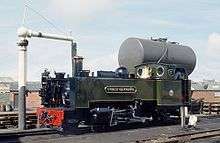GWR Rheidol Tank
| GWR Rheidol Tank | |||||||||||||||||||||
|---|---|---|---|---|---|---|---|---|---|---|---|---|---|---|---|---|---|---|---|---|---|
 Llywelyn outside the locomotive works in Aberystwyth in 2015 | |||||||||||||||||||||
| |||||||||||||||||||||
| |||||||||||||||||||||
| |||||||||||||||||||||
| |||||||||||||||||||||
The GWR Rheidol Tanks are a fleet of 2-6-2 steam locomotives of the Great Western Railway design built between 1923 and 1924. They were designed by the railway's Chief Mechanical Engineer, Charles Collett, for working services on the Vale of Rheidol Railway between Aberystwyth and Devil's Bridge.
Background
Prior to the grouping of in independent railway, the Vale of Rheidol Railway was operated by the Cambrian Railways. The fleet consisted of two locomotives built by Davies and Metcalfe, supplented by a Bagnall locomotive.
Shortly after taking control of the line, the GWR realised that the original rolling stock was in a poor state of repair. They built three new locomotives (numbered 7, 8 and 1213) at the GWR's Swindon Works. Number 1213 was later renumbered 9.
Mistaken identity
It is still possible to find references (in print, and on-line) to the mistaken belief that No 9 is one of the original Davies & Metcalfe Locomotives,[1] as some websites and books incorrectly perpetuate this myth,[2] having been successfully hoodwinked by Swindon Works.[3] The Works were very effective in their coverup, entitling the parts that made up the new No 1213 as 'spares' in the accounts book, as the GWR Board had only given them leave to build two new locomotives (No 7 & No 8).[4] A simple test to prove that No 9 is actually of the same vintage as No 7 & No 8 is to compare the working drawings between it and a Davies and Metcalfe locomotive — Rheidol historian C C Green, who carried out this comparison, stated of all three current locomotives that "mechanically they are identical", and having compared the current No 9 (the 'new' 1213) with the plans of the original 1213 stated that "no single part" of the original locomotive could possibly have fitted the new one.[5]
Over the winter of 1948/9, In 1946, the GWR undertook a renumbering of the remaining locomotives inherited from pre-Grouping companies, and this saw the 'new' 1213 being renumbered as No 9.[6]
British Rail ownership
Along with other ex-GWR locomotives, No 7, No 8, & No 9 all retained their numbers under British Railways ownership, and in 1956 were given the names which they still carry today, being unnamed up to that point. These three locos were the only steam engines to survive in BR's ownership after the end of mainline steam traction in August 1968, excluding steam powered cranes which remained in service until 1995. Under the TOPS numbering arrangements introduced at this time they were allocated Class 98 and were nominally numbered 98007–98009, but these numbers were never actually carried on the locomotives. All three locomotives, and the rolling stock, carried standard British Rail 'rail blue' livery until the 1980s, when the locomotives were given more traditional liveries that they had carried in the past.
Conversion to oil firing
The locomotives were originally designed to burn coal, however there was a period spanning over thirty years during which the three locomotives were oil fired. Problems with sparks and unreliability of the coal supplied caused British Railways to look to alternative fuels for the locomotives. Locomotive No 7 was the first to be converted in 1978, followed by No 8 in 1979 and No 9 in 1981.[7] This change was later reversed with Locomotive No 8 returning to coal in 2012 and No 9 in 2013.
Preservation
All three Vale of Rheidol tanks are still in service and operating on their original route.
The standard livery is Great Western Railway green and all three locomotives currently carry this livery. The locomotives were named by British Railways in 1956 and currently do not carry their nameplates.
| Image | Number | Name | Year built | Notes | In Traffic? |
|---|---|---|---|---|---|
 |
7 | Owain Glyndŵr | 1923 | Hauled the last steam service under British Rail ownership of the line. | Under Overhaul |
 |
8 | Llywelyn | 1923 | In Traffic | |
 |
9 (1213) | Prince of Wales | 1924 | Numbered 1213 from delivery until gaining the No 9 in 1948.[8] Put through Swindon works as an overhaul of the original No 2, but is in fact a complete new locomotive.[9] As of November 2016 the locomotive carries No 1213 once more. | In Traffic |
See also
References
- ↑ See, for example, Michael Rutherford, 'Railway Reflections No 129', photo caption of Nos 8 and 'new' 1213, the latter referenced as 'formerly No 2': photo captions indexed at SteamIndex, here.
- ↑ See, for example, the incorrect locomotive data catalogued here by the Narrow Gauge Railway Museum website.
- ↑ See 'Vale of Rheidol Light Railway', by W J K Davies, published 1964 by Ian Allen Limited, for a discussion of the accounting coverup.
- ↑ See British Heritage Railways website, section headed 'locomotives'.
- ↑ Green,1986, Page 189.
- ↑ Green,1986, Page 192.
- ↑ Green,1986, Page 201-203
- ↑ Green 1986, page 192
- ↑ Green 1986, page 189
Bibliography
- Green, CC (1986). The Vale of Rheidol Light Railway. Wild Swan. ISBN 0-906867-43-6.
- Boyd, James I.C. (1965). Narrow Gauge Railways in Mid Wales. Oakwood Press. ISBN 0-85361-024-X.
- Johnson, Peter (1999). Welsh Narrow Gauge: a view from the past. Ian Allan Publishing. ISBN 0-7110-2654-8.
- Johnson, Peter (2011). An Illustrated History of the Great Western Narrow Gauge. OPC. ISBN 978-0-86093-636-7.
External links
| Wikimedia Commons has media related to Vale of Rheidol Railway. |